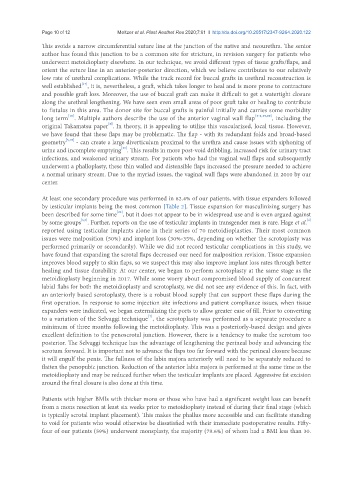Page 722 - Read Online
P. 722
Page 10 of 12 Meltzer et al. Plast Aesthet Res 2020;7:61 I http://dx.doi.org/10.20517/2347-9264.2020.122
This avoids a narrow circumferential suture line at the junction of the native and neourethra. The senior
author has found this junction to be a common site for stricture, in revision surgery for patients who
underwent metoidioplasty elsewhere. In our technique, we avoid different types of tissue grafts/flaps, and
orient the suture line in an anterior-posterior direction, which we believe contributes to our relatively
low rate of urethral complications. While the track record for buccal grafts in urethral reconstruction is
[17]
well established , it is, nevertheless, a graft, which takes longer to heal and is more prone to contracture
and possible graft loss. Moreover, the use of buccal graft can make it difficult to get a watertight closure
along the urethral lengthening. We have seen even small areas of poor graft take or healing to contribute
to fistulas in this area. The donor site for buccal grafts is painful initially and carries some morbidity
[18]
long term . Multiple authors describe the use of the anterior vaginal wall flap [2-4,19,20] , including the
[6]
original Takamatsu paper . In theory, it is appealing to utilize this vascularized, local tissue. However,
we have found that these flaps may be problematic. The flap - with its redundant folds and broad-based
geometry [5,19] - can create a large diverticulum proximal to the urethra and cause issues with siphoning of
[21]
urine and incomplete emptying . This results in more post-void dribbling, increased risk for urinary tract
infections, and weakened urinary stream. For patients who had the vaginal wall flaps and subsequently
underwent a phalloplasty, these thin walled and distensible flaps increased the pressure needed to achieve
a normal urinary stream. Due to the myriad issues, the vaginal wall flaps were abandoned in 2010 by our
center.
At least one secondary procedure was performed in 82.4% of our patients, with tissue expanders followed
by testicular implants being the most common [Table 2]. Tissue expansion for masculinizing surgery has
been described for some time , but it does not appear to be in widespread use and is even argued against
[22]
[4]
[5,7]
by some groups . Further, reports on the use of testicular implants in transgender men is rare. Hage et al.
reported using testicular implants alone in their series of 70 metoidioplasties. Their most common
issues were malposition (50%) and implant loss (30%-35%, depending on whether the scrotoplasty was
performed primarily or secondarily). While we did not record testicular complications in this study, we
have found that expanding the scrotal flaps decreased our need for malposition revision. Tissue expansion
improves blood supply to skin flaps, so we suspect this may also improve implant loss rates through better
healing and tissue durability. At our center, we began to perform scrotoplasty at the same stage as the
metoidioplasty beginning in 2017. While some worry about compromised blood supply of concurrent
labial flabs for both the metoidioplasty and scrotoplasty, we did not see any evidence of this. In fact, with
an anteriorly based scrotoplasty, there is a robust blood supply that can support these flaps during the
first operation. In response to some injection site infections and patient compliance issues, when tissue
expanders were indicated, we began externalizing the ports to allow greater ease of fill. Prior to converting
[7]
to a variation of the Selvaggi technique , the scrotoplasty was performed as a separate procedure a
minimum of three months following the metoidioplasty. This was a posteriorly-based design and gives
excellent definition to the penoscrotal junction. However, there is a tendency to make the scrotum too
posterior. The Selvaggi technique has the advantage of lengthening the perineal body and advancing the
scrotum forward. It is important not to advance the flaps too far forward with the perineal closure because
it will engulf the penis. The fullness of the labia majora anteriorly will need to be separately reduced to
flatten the penopubic junction. Reduction of the anterior labia majora is performed at the same time as the
metoidioplasty and may be reduced further when the testicular implants are placed. Aggressive fat excision
around the final closure is also done at this time.
Patients with higher BMIs with thicker mons or those who have had a significant weight loss can benefit
from a mons resection at least six weeks prior to metoidioplasty instead of during their final stage (which
is typically scrotal implant placement). This makes the phallus more accessible and can facilitate standing
to void for patients who would otherwise be dissatisfied with their immediate postoperative results. Fifty-
four of our patients (59%) underwent monsplasty, the majority (79.6%) of whom had a BMI less than 30.

